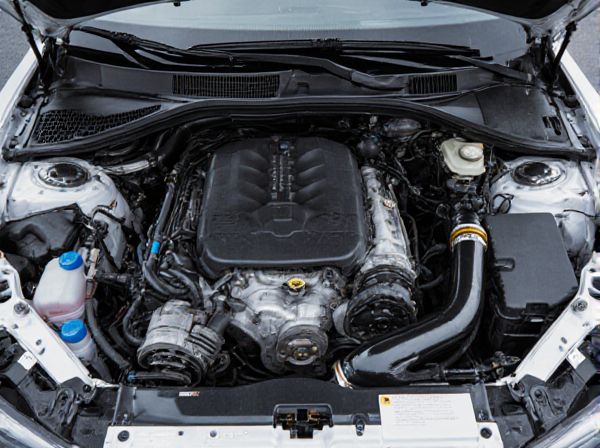
Photo illustration: Long-Runner Intake Manifold vs Short-Runner Intake Manifold
Long-runner intake manifolds improve low-end torque by maximizing air velocity and volumetric efficiency at lower RPMs, ideal for everyday driving and off-road performance. Short-runner intake manifolds enhance high-RPM power by reducing airflow resistance, making them suitable for racing and high-performance applications. Your choice depends on whether you prioritize torque for acceleration or peak horsepower for speed.
Table of Comparison
| Feature | Long-Runner Intake Manifold | Short-Runner Intake Manifold |
|---|---|---|
| Design | Long, curved intake runners | Short, straight intake runners |
| Performance Focus | Enhances low to mid-range torque | Optimizes high-RPM horsepower |
| Airflow Dynamics | Improves air velocity at low engine speeds | Reduces air resistance for maximum flow at high speeds |
| Engine Efficiency | Better fuel economy under normal driving conditions | Higher performance, potentially lower fuel efficiency |
| Common Applications | Everyday vehicles, trucks, and torque-focused engines | Sports cars, racing engines, and high-performance setups |
| Impact on Throttle Response | Smoother, more gradual throttle response | Sharper, more immediate throttle response |
Introduction to Intake Manifolds
Intake manifolds distribute air evenly to each cylinder for optimal combustion efficiency in internal combustion engines. Long-runner intake manifolds feature extended runners that enhance low-end torque by increasing air velocity, while short-runner manifolds use shorter paths to improve high-RPM power and maximum airflow. The design choice impacts engine performance, fuel efficiency, and throttle response depending on application requirements.
Understanding Long-Runner Intake Manifolds
Long-runner intake manifolds feature elongated intake paths designed to enhance low to mid-range torque by promoting better air-fuel mixture velocity and improving cylinder filling efficiency. Their length creates a resonance effect that optimizes volumetric efficiency at lower engine speeds, resulting in increased torque output and improved drivability. This design is particularly beneficial for naturally aspirated engines seeking better fuel economy and smoother power delivery in everyday driving conditions.
Exploring Short-Runner Intake Manifolds
Short-runner intake manifolds are designed to optimize airflow for higher RPM performance by reducing the distance air travels, which enhances throttle response and increases peak power output. These manifolds are commonly used in high-performance and racing engines where maximizing horsepower at elevated engine speeds is critical. Their shorter path length minimizes air resistance, promoting better engine breathing and improved volumetric efficiency during rapid acceleration.
Performance Differences: Long-Runner vs Short-Runner
Long-runner intake manifolds enhance low-end torque and improve engine efficiency at lower RPM by increasing air velocity and promoting better cylinder filling, making them ideal for street driving and fuel economy. Short-runner intake manifolds optimize airflow at high RPM, boosting peak horsepower and throttle response, which benefits racing and high-performance applications. The trade-off between long-runner and short-runner designs lies in their RPM range effectiveness, with long runners favoring torque and fuel efficiency, while short runners prioritize maximum power output.
Impact on Engine Torque and Horsepower
Long-runner intake manifolds enhance low to mid-range engine torque by promoting better air velocity and filling the cylinders more effectively at lower RPMs, which improves throttle response and fuel efficiency. Short-runner intake manifolds favor high-RPM horsepower by minimizing air resistance and enabling greater airflow, essential for peak engine performance in sports cars and racing applications. Engine tuning often balances runner length to optimize torque for regular driving conditions or horsepower for performance demands, depending on the vehicle's primary use.
Role in Airflow and Fuel Mixture
Long-runner intake manifolds optimize airflow by creating higher air velocity, which enhances low-end torque and improves fuel mixture atomization for better combustion efficiency in engines operating at lower RPMs. Short-runner intake manifolds maximize airflow volume and reduce air resistance, promoting better high-RPM performance by delivering a denser air-fuel mixture, thus increasing power output at higher engine speeds. The choice between long-runner and short-runner designs directly impacts engine responsiveness, fuel efficiency, and overall performance characteristics by altering airflow dynamics and fuel atomization quality.
Applications: When to Use Each Type
Long-runner intake manifolds excel in low-end torque delivery and fuel efficiency, making them ideal for everyday driving and vehicles requiring strong low to mid-range performance, such as sedans and trucks. Short-runner intake manifolds enhance high-RPM horsepower and throttle response, preferred in sports cars and racing applications where maximum engine output at higher speeds is critical. Selecting the appropriate manifold depends on desired power characteristics: prioritize long-runner designs for torque and fuel economy, and short-runner designs for peak power and aggressive acceleration.
Tuning and Modifications for Optimal Performance
Long-runner intake manifolds enhance low to mid-range torque by promoting better air velocity and cylinder filling, making them ideal for street tuning and modifications aimed at daily drivability and fuel efficiency. Short-runner intake manifolds increase high-RPM horsepower by reducing air resistance and improving airflow at higher engine speeds, benefiting track-focused builds and performance modifications. Selecting between long-runner and short-runner manifolds depends on the intended powerband and the specific tuning strategy, where cam profile, forced induction, and exhaust setup play critical roles in optimizing overall engine performance.
Pros and Cons of Long-Runner and Short-Runner Designs
Long-runner intake manifolds enhance low-end torque and improve fuel atomization by increasing air velocity, making them ideal for street driving and fuel efficiency, but they can limit high-RPM power due to airflow restrictions. Short-runner intake manifolds excel at high-RPM horsepower production by reducing intake air resistance and allowing increased airflow, though they often sacrifice low-end torque and throttle response. Selecting between long-runner and short-runner designs depends on the desired engine performance characteristics, with long runners favoring torque and drivability and short runners optimizing peak power.
Conclusion: Choosing the Right Intake Manifold
Long-runner intake manifolds enhance low to mid-range torque by increasing air velocity and improving cylinder filling, making them ideal for daily driving and fuel efficiency. Short-runner intake manifolds optimize airflow for high RPM power, benefiting performance enthusiasts seeking maximum horsepower. Selecting the right intake manifold depends on the desired engine characteristics and driving conditions, balancing torque and power outputs to match specific vehicle needs.
 caratoz.com
caratoz.com